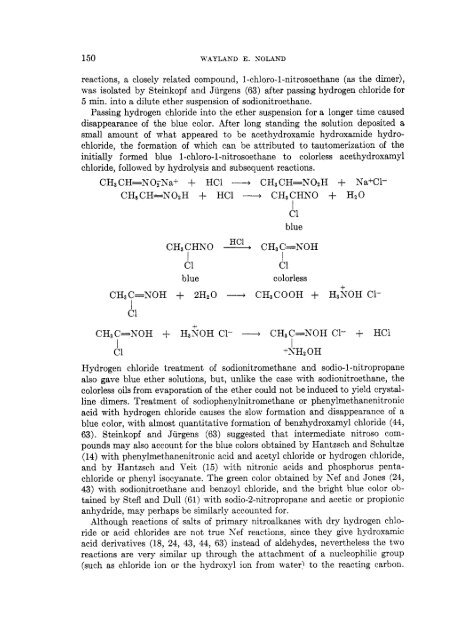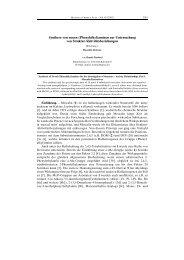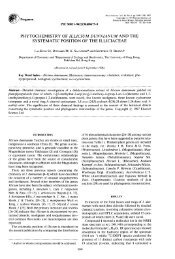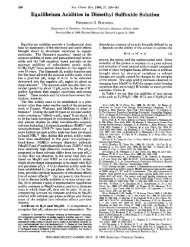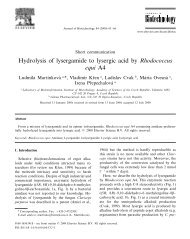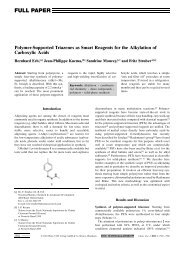Nef reaction
Nef reaction
Nef reaction
Create successful ePaper yourself
Turn your PDF publications into a flip-book with our unique Google optimized e-Paper software.
150 WAYLAND E. XOLAND<br />
<strong>reaction</strong>s, a closely related compound, 1-chloro-1-nitrosoethane (as the dimer),<br />
was isolated by Steinkopf and Jurgens (63) after passing hydrogen chloride for<br />
5 min. into a dilute ether suspension of sodionitroethane.<br />
Passing hydrogen chloride into the ether suspension for a longer time caused<br />
disappearance of the blue color. After long standing the solution deposited a<br />
small amount of what appeared to be acethydroxamic hydroxamide hydro-<br />
chloride, the formation of which can be attributed to tautomerization of the<br />
initially formed blue 1-chloro-1-nitrosoethane to colorless acethydroxamyl<br />
chloride, followed by hydrolysis and subsequent <strong>reaction</strong>s.<br />
CH3CH=NOzNa+ + HC1 --+ CH3CH=N02H + Na+Cl-<br />
CHSCH=NOzH + HC1 CHZCHNO + HzO<br />
I<br />
c1<br />
blue<br />
- HCI<br />
CH3CHNO CHzC=I\;OH<br />
I<br />
I<br />
c1<br />
-<br />
c1<br />
blue colorless<br />
+<br />
CH3C=NOH + 2Hz0 CH3COOH + HsNOH C1-<br />
I<br />
c1<br />
+<br />
CHaC=NOH + HsXoH C1- ---+ CHBC=NOH C1- + HC1<br />
I I<br />
c1 +SHz OH<br />
Hydrogen chloride treatment of sodionitromethane and sodio-1-nitropropane<br />
also gave blue ether solutions, but, unlike the case with sodionitroethane, the<br />
colorless oils from evaporation of the ether could not be induced to yield crystal-<br />
line dimers. Treatment of sodiophenylnitromethane or phenylmethanenitronic<br />
acid with hydrogen chloride causes the slow formation and disappearance of a<br />
blue color, with almost quantitative formation of benzhydroxamyl chloride (44,<br />
63). Steinkopf and Jurgens (63) suggested that intermediate nitroso com-<br />
pounds may also account for the blue colors obtained by Hantzsch and Schultze<br />
(14) with phenylmethanenitronic acid and acetyl chloride or hydrogen chloride,<br />
and by Hantzsch and Veit (15) with nitronic acids and phosphorus penta-<br />
chloride or phenyl isocyanate. The green color obtained by Kef and Jones (24,<br />
43) with sodionitroethane and benzoyl chloride, and the bright blue color ob-<br />
tained by Stefl and Dull (61) with sodio-2-nitropropane and acetic or propionic<br />
anhydride, may perhaps be similarly accounted for.<br />
Although <strong>reaction</strong>s of salts of primary nitroalkanes with dry hydrogen chlo-<br />
ride or acid chlorides are not true Sef <strong>reaction</strong>s, since they give hydroxamic<br />
acid derivatives (18, 24, 43, 44, 63) instead of aldehydes, nevertheless the two<br />
<strong>reaction</strong>s are very similar up through the attachment of a nucleophilic group<br />
(such as chloride ion or the hydroxyl ion from water’ to the reacting carbon.


